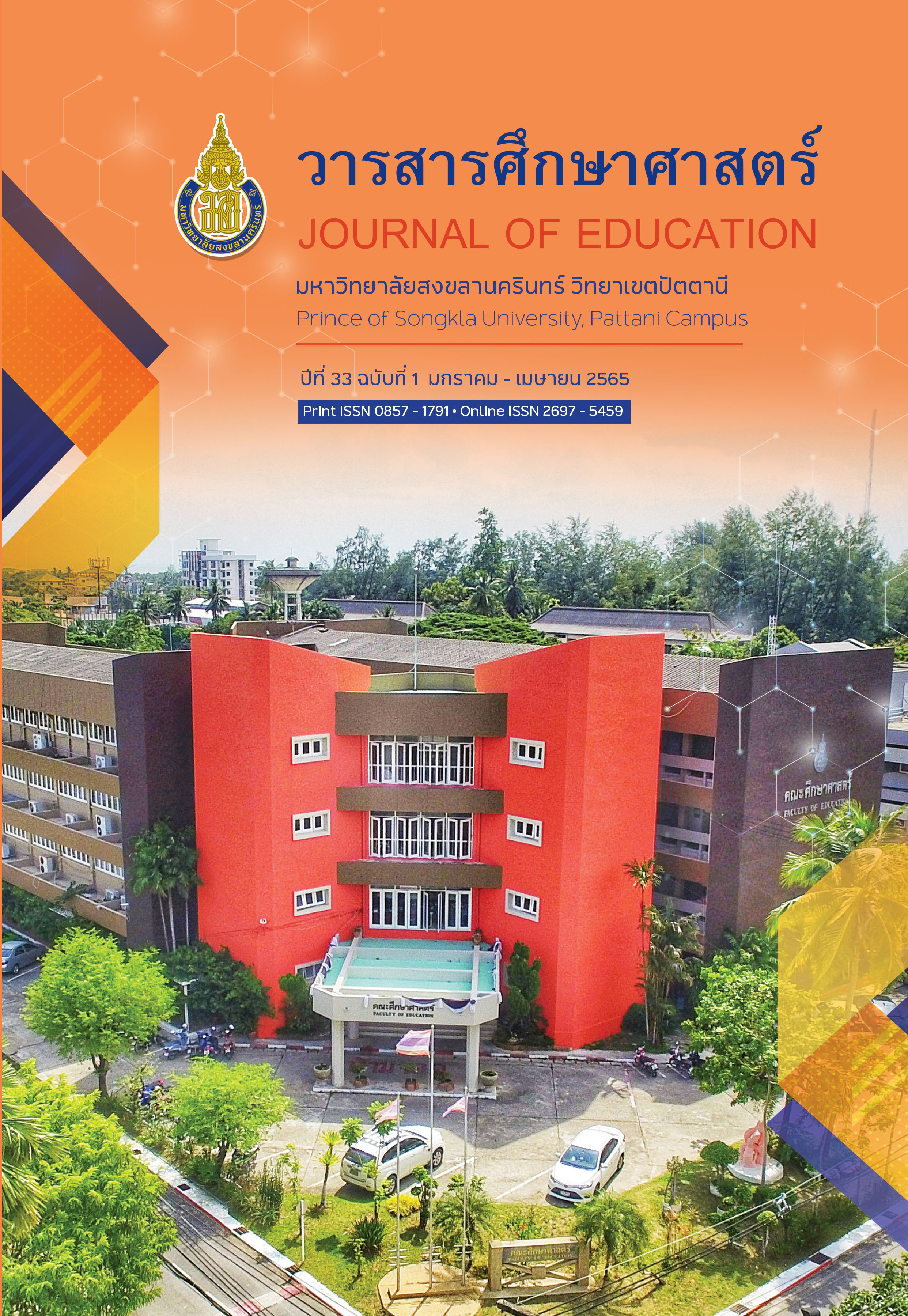ทักษะการใช้สื่อโสตทัศนูปกรณ์ การพัฒนาบทเรียนออนไลน์เพื่อเสริมสร้างทักษะการใช้สื่อโสตทัศนูปกรณ์ ยุคศตวรรษที่ 21 สำหรับผู้ใช้ในระดับอุดมศึกษา มหาวิทยาลัยวงษ์ชวลิตกุล
Main Article Content
บทคัดย่อ
การวิจัยและพัฒนาครั้งนี้มีวัตถุประสงค์เพื่อ 1) ศึกษาสภาพปัญหาการใช้สื่อโสตทัศนูปกรณ์ ยุคศตวรรษที่ 21 สำหรับผู้ใช้ในระดับอุดมศึกษา 2) พัฒนาบทเรียนออนไลน์เพื่อเสริมสร้างทักษะการใช้สื่อโสตทัศนูปกรณ์ 3) สร้างแบบประเมินความพึงพอใจของผู้ใช้ในระดับอุดมศึกษาเก็บข้อมูลจากกลุ่มตัวอย่างที่ได้จากการสุ่มแบบหลายขั้นตอนจำนวน 30 คน ประกอบด้วย อาจารย์ผู้สอน ผู้ช่วยสอน และบุคลากรที่ใช้สื่อโสตทัศนูปกรณ์ เครื่องมือวิจัยคือ แบบสอบถามที่มีค่าดัชนีความสอดคล้อง (Index of item objective congruence: IOC) ระหว่าง 0.67-1.00 และมีค่าความเที่ยงเท่ากับเที่ยง 0.75 วิเคราะห์ข้อมูลโดยใช้สถิติค่าความถี่ ร้อยละ ค่าเฉลี่ย และส่วนเบี่ยงเบนมาตรฐาน
ผลการวิจัยพบว่า 1) สภาพปัญหาการใช้สื่อโสตทัศนูปกรณ์ของผู้ใช้ ได้แก่ (1) ผู้ใช้ไม่เข้าใจหลักการทำงานอุปกรณ์สื่อเท่าที่ควร ค่าเฉลี่ยเท่ากับ 3.90 (2) ระบบขั้นตอนการใช้งานซับซ้อน ค่าเฉลี่ยเท่ากับ 3.60 (3) ผู้ใช้ตามไม่ทันเทคโนโลยีที่ทันสมัยและขาดความรู้ด้านเทคนิคการต่ออุปกรณ์ ค่าเฉลี่ยเท่ากับ 3.30 และ (4) ไม่มีการอบรมแนะนำก่อนใช้งาน ค่าเฉลี่ยเท่ากับ 3.00 2) บทเรียนออนไลน์ที่พัฒนาขึ้นมา ผ่านการประเมินคุณภาพโดยผู้ทรงคุณวุฒิ 3 ท่าน โดยมีคะแนนเฉลี่ยประเมินแต่ละด้าน ดังนี้ (1) แผนการจัดการเรียนบทเรียนออนไลน์ คะแนนเฉลี่ยอยู่ในระดับดีมาก ( = 4.62, S.D. = 0.66) (2) และการพัฒนาโปรแกรม คะแนนเฉลี่ยอยู่ในระดับดีมาก (
= 4.65, S.D.= 0.57) ประสิทธิภาพของบทเรียนออนไลน์ มีค่าเท่ากับ 81.10/82.66 (3) แบบทดสอบวัดผลสัมฤทธิ์ มีค่าดัชนีความสอดคล้องระหว่าง 0.67 - 1.00 และมีค่าความเที่ยงเท่ากับ 0.75 มีความเชื่อมั่นเท่ากับ 0.94 ค่าอำนาจจำแนก (r) ระหว่าง 0.20-0.60 และ (4) แบบวัดทักษะปฏิบัติ มีค่าดัชนีความสอดคล้องระหว่าง 0.67 - 1.00 3) สร้างแบบประเมินความพึงพอใจของผู้ใช้ระดับอุดมศึกษาพบว่ามีความตรงตามเนื้อหาโดยมีค่าดัชนีความสอดคล้องระหว่าง 0.67 - 1.00
Article Details

อนุญาตภายใต้เงื่อนไข Creative Commons Attribution-NonCommercial 4.0 International License.
เอกสารอ้างอิง
Arterbury, E.H. (1972). Teacher Utilization of Media Service Provide by the Regional Service Centers in Texas. [Dissertation Abstracts International]. Texas Regional Education Service Centers.
Ashaver, D. & Igyuve, S.M. (2013). The Use of Audio-Visual Materials in the Teaching and Learning Processes in Colleges of Education in Benue State-Nigeria. IOSR-JRME, 1(6), 44-55.
Boonjarean, P. (2005). The Construction of Online Lesson by Using Learning Management System on Internet Network in Design in Web Screen. [Master’s degree Thesis of Industrial Education, Technology of Education, King Mongkut’s University of Technology Thonburi]. [in Thai]
Chailapo, T., Poksupphiboon, A., & Sopa, P. (2016) Online Learning Media Development: Design for Interactive Media Production. Srinakharinwirot University. The journal of social communication innovation, 4(2),134-143. [in Thai]
Chookhampaeng, C. (2016). Curriculum Research and Development Concept and Process. Chulalongkorn University Press. [in Thai]
Chunwiset, B. (2009). The Construction of Online Lesson in Data and Network Communication. [Master’s degree Thesis of Science in Industrial Education, Technology of Education, King Mongkut’s University of Technology Thonburi]. [in Thai]
Gagné, R. M. (1985). The Conditions of Learning and Theory of Instruction. (4th ed) New York: Holt, Rinehart, and Winston.
Khan, B. H. (1997). Web-based Instruction. Englewood Cliffs. Education Technology Publication.
Lynch, P. and Horton, S. (2002). Web Style Guide: Basic Design Principles for Creating Web Sites. 2nd ed, New Haven and London: Yale University Press.
Mehren, W. A. & Lehmann, I. J. (1973). A Measurement and evaluation in education and psychology. New York, Holt. Rinehart and Winston
Morrison, J. L. & Khan, B. H. (2003). The global e-learning framework: An interview with Badrul Khan. The Technology Source. A Publication of the Michigan Virtual University. The Standard. Retrieved from https://www.academia.edu/2478564/The_Global_e_ Learning_ Framework_by_Badrul_H_Khan
Na Song Klar, J. (1999). Teaching through World Wide Web (www). Journal of Education Studies, 27(3), 18-28. [in Thai]
Nilsook, P. (2007). E-learning in higher education and training. Journal of Ramphotong Southeast Asian University, 17(2), 26-32. [in Thai]
Office of Higher Education Commission. (2018). The Long-Term Higher Education Plan for 20 Years 2018 – 2037. Prickwarn graffic. [in Thai]
Pannim, P. (2016). Development of Web-Based Instruction Model Blended with Cooperative Learning. Journal of VRU Research and Development, 11(2), 121-129. [in Thai]
Panpeng, Y. (2013). Instruction Design By E-Learning System. Journal of Sripatum Chonburi, 15(2-3), 103-112. [in Thai]
Pastor, A.A. &Tavares, M.M. (2019). Literature review of audiovisual practices in Nursing education. Rev Bras Enferm, 72(1), 190-199.
Pichianchareon, P. (2004). Internet Lessons Development: Audio-Visual Aids: Journal of Academic Resources, 15(2-3), 103-112. [in Thai]
Prasatsil, P. (2015). The Development of e-Learning Using Edmodo on Preparing English for Work for Undergraduate Students, Faculty of Liberal Arts. Rajamangala University of Technology Suvarnabhum, Suphan Buri Center. Rajamangala University of Technology Suvarnabhum, Suphan Buri Center. [in Thai]
Rovinelli, R.J. & Hambleton, R.K. (1976). On the use of content specialists in the assessment of criterion-referenced test item validity. Paper presented at the annual meeting of the American Educational Research Association: California. The Standard. Retrieved from https://files.eric.ed.gov/fultlext/ED121845.pdf
Shelly, M. W. (1975). Responding to Social Change. Pennsylvania: Dowden Huntchisam Press. Inc.
Tiwasingha, S., Kaewrat, S., Jung Sathitkun, W., & Dedkhunthot, N. (2013). The Study of Audiovisual Service Development at Central Library Information and Resources Center Khon Kaen University in Fiscal year 2009. The Standard. Retrieved from http://infojournal.kku.ac.th/index.php/information/article/view/388 [in Thai]


